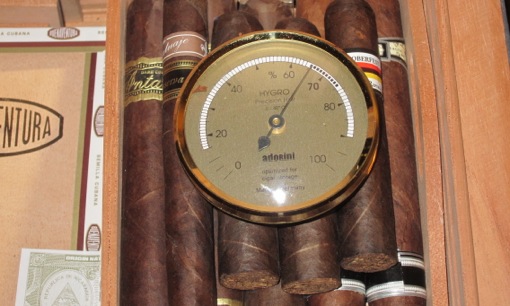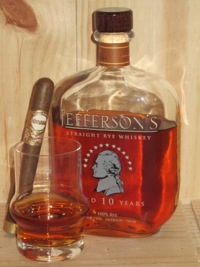Cigar Tip: Beyond the Basics of Humidity
24 Apr 2014
There was a time when I stressed over keeping my cigars at a perfect humidity. These days, I’m not so fussy about monitoring my humidors on a day-to-day basis.

When you first get into cigars, you read often that 70/70 (humidity/temperature) is the ideal way to store your cigars. Soon, though, you probably realize that a slightly lower humidity (62-65%) is better, especially if you are storing cigars for long-term aging.
We’ve covered the fundamentals of proper humidity before, but as the outside temperature gets hotter it’s a good time to recap. Anywhere from 62-70% is generally fine. (You can even go all out and build your own temperature-controlled humidor.)
It’s often a matter of personal preference if you like your cigars a little drier. On the low end of that range, your cigars are certain to burn easily, but possibly a bit quick and hot.
Of course, the first step in proper humidity is making sure your hygrometer is properly calibrated, especially for the inexpensive spring-loaded hygrometers that come with most humidors. For that you want to to use the salt calibration test.
Eventually, though, you might get to the stage where you don’t even need a hygrometer. I now keep most of my cigars in humidors without one, since I can tell by feel, and by how my cigars are smoking, when it’s time to add a little more distilled water or humidor solution.
I’ve gotten to the point where I’m really only concerned about keeping a select few cigars at their ideal humidity. Over time I’ve found certain cigars smoke better at slightly higher or lower humidity levels. Thick broadleaf wrappers, in particular, tend to benefit from a slightly higher humidity. This is especially true of Liga Privada, which will produce smoke like a chimney at almost any humidity. (Sometimes I’ll leave a 70% or 72% Boveda pack in a box with these cigars within my larger humidor.)
Other cigars, I may pull out of the humidor a few hours before smoking to let the humidity drop a bit before lighting it up. Cigars with a closed foot, which is becoming more common, tend to hold moisture more easily than a traditional foot so they may benefit from this. The same goes for cigars with a particularly firm draw.
Ultimately, it’s a case of trial and error, and you may want to experiment a bit. Tweaking the humidity won’t make a bad cigar good, but it might just make a favorite of yours a little bit better, so give it a try.
photo credit: Stogie Guys


 But most Canadian whiskey doesn’t meet the “straight rye” designation since the rye is often mixed with neutral grain spirits (basically vodka), to produce the low-proof, smooth-drinking Canadian whiskey you might be familiar with. And yet lots of rye is made in Canada, which caught the eye of some American whiskey sellers as old aged rye has gained a larger and larger following with American whiskey fans.
But most Canadian whiskey doesn’t meet the “straight rye” designation since the rye is often mixed with neutral grain spirits (basically vodka), to produce the low-proof, smooth-drinking Canadian whiskey you might be familiar with. And yet lots of rye is made in Canada, which caught the eye of some American whiskey sellers as old aged rye has gained a larger and larger following with American whiskey fans.

 While a number of states are considering expanded smoking bans and increased tobacco taxes, the New Jersey law would be the first time a state would tax tobacco advertising. New Jersey already taxes
While a number of states are considering expanded smoking bans and increased tobacco taxes, the New Jersey law would be the first time a state would tax tobacco advertising. New Jersey already taxes  Releasing two similarly branded cigars (one for cigar shops, the other for online/catalog) seems to be a new strategy General Cigar is embracing, since they did something similar with La Gloria Cubana Serie R Black/Serie R EstelÃ. The idea, I suspect, is to protect cigar shops from online competition and vice versa, while having the branding, packaging, and profile be similar enough that each benefits from the publicity and marketing of the other.
Releasing two similarly branded cigars (one for cigar shops, the other for online/catalog) seems to be a new strategy General Cigar is embracing, since they did something similar with La Gloria Cubana Serie R Black/Serie R EstelÃ. The idea, I suspect, is to protect cigar shops from online competition and vice versa, while having the branding, packaging, and profile be similar enough that each benefits from the publicity and marketing of the other.
 Patrick Ashby
Co-Founder & Editor in Chief
Patrick Ashby
Co-Founder & Editor in Chief Patrick Semmens
Co-Founder & Publisher
Patrick Semmens
Co-Founder & Publisher George Edmonson
Tampa Bureau Chief
George Edmonson
Tampa Bureau Chief